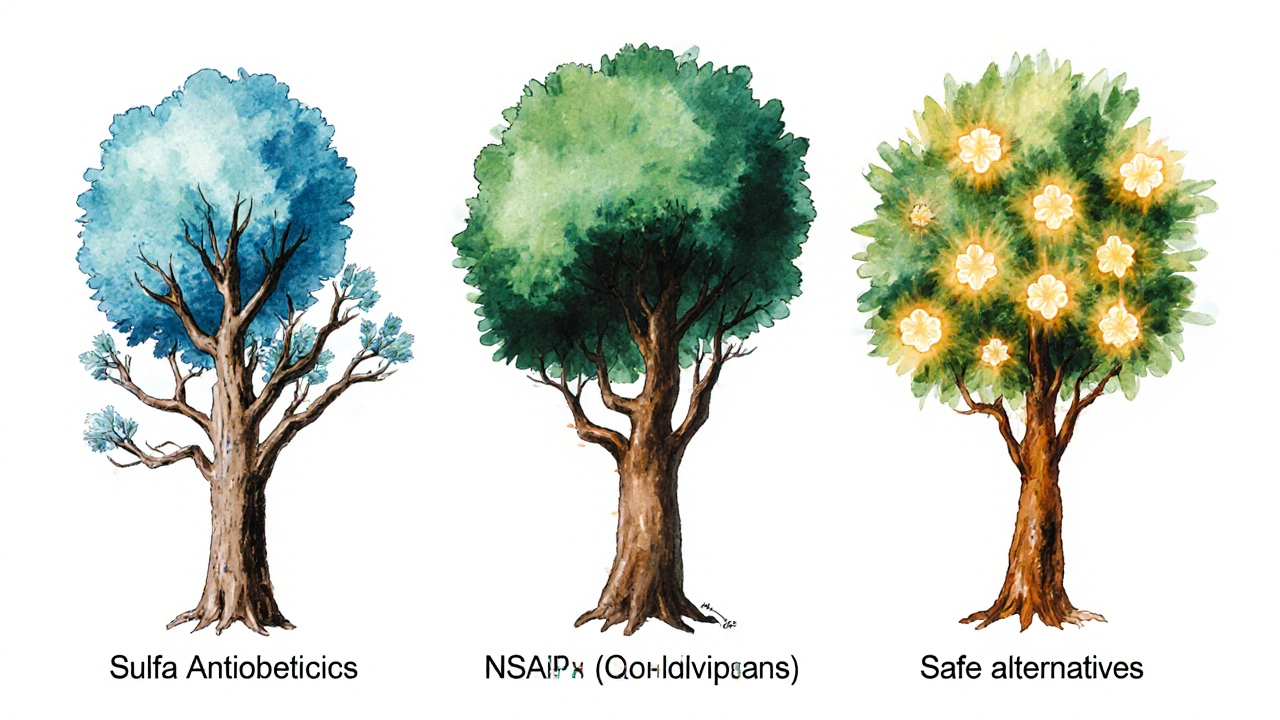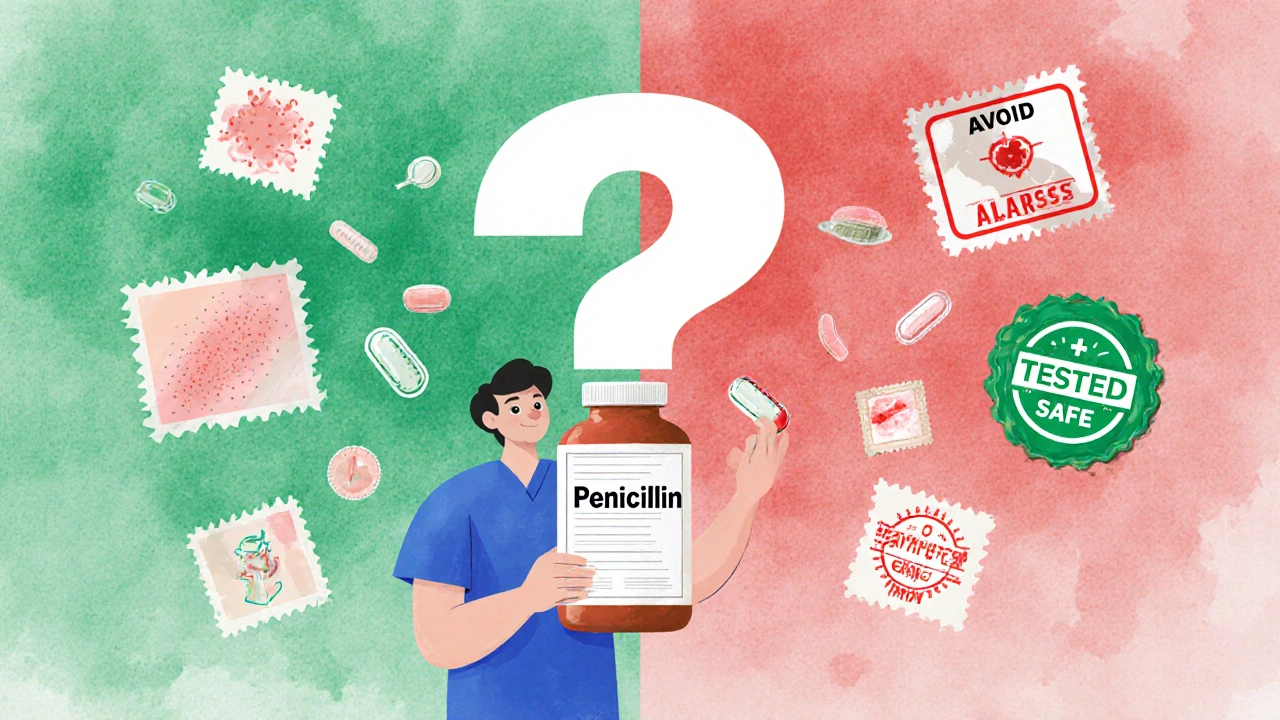When you’ve had a severe reaction to a drug, it’s natural to want to avoid anything even remotely similar. But not every reaction means you need to avoid an entire class of medications. Too often, people are told to steer clear of whole families of drugs-like all penicillins or all NSAIDs-based on a single bad experience. That might sound safe, but it can actually put you at greater risk: fewer treatment options, longer hospital stays, and even more dangerous alternatives. The real question isn’t just when to avoid a medication family-it’s how to know for sure whether you really need to.
Not All Reactions Are Allergies
Many people think a rash or stomach upset after taking a pill means they’re allergic. But that’s not always true. In fact, 80 to 90% of reported drug reactions aren’t allergic at all. They’re side effects-predictable, dose-related, and often harmless if managed differently. For example, a mild rash from amoxicillin is common in kids and doesn’t mean you’re allergic to all penicillins. It’s more likely a viral rash coinciding with the antibiotic. True allergic reactions involve your immune system. These are the ones that scare doctors: hives, swelling of the lips or tongue, trouble breathing, or full-blown anaphylaxis. These usually happen within minutes to hours. If you’ve had any of these, it’s a red flag. But even then, not every drug in the same family is off-limits.Severe Skin Reactions: Always Avoid the Whole Class
If you’ve had Stevens-Johnson syndrome (SJS), toxic epidermal necrolysis (TEN), or DRESS (drug reaction with eosinophilia and systemic symptoms), you need to avoid the entire drug family-no exceptions. These are rare but deadly. TEN alone kills up to half the people who get it. And once you’ve had one, your risk of another is extremely high. The drugs most often linked to these reactions? Antibacterial sulfonamides like Bactrim, anticonvulsants like carbamazepine, allopurinol, and some NSAIDs. The European Medicines Agency found that just six drug classes cause 95% of all TEN cases. If you’ve had a reaction to one of these, you should never take another drug in the same group-even if it’s a different brand or slightly different chemical structure.Penicillin and Other Antibiotics: Don’t Assume the Worst
Penicillin is the most common drug allergy label in the U.S. But here’s the shocker: 95% of people who think they’re allergic to penicillin aren’t. Most were told they were allergic after a mild rash as a child, or because a parent had the label. Few ever got tested. Studies show that less than 10% of people with a penicillin label actually have a true IgE-mediated allergy. That means you could safely take amoxicillin, cephalexin, or even other beta-lactams-after proper testing. Skin tests and drug challenges under medical supervision can confirm this. In fact, 70 to 85% of patients with low-risk histories pass a challenge test. The problem? Many doctors still avoid all penicillins if one is labeled. That pushes patients toward broader-spectrum antibiotics like vancomycin or fluoroquinolones, which are more expensive, harder on the gut, and increase antibiotic resistance. Don’t let an old label cost you better care.
Sulfa Drugs: It’s Not What You Think
People often confuse sulfa antibiotics with other sulfa-containing drugs. If you had a reaction to Bactrim (sulfamethoxazole-trimethoprim), you don’t need to avoid all sulfa drugs. Diabetic medications like glipizide, diuretics like hydrochlorothiazide, and even some migraine drugs contain sulfonamide groups-but they’re chemically different from the antibiotic ones. Cross-reactivity between sulfa antibiotics and other sulfa drugs is only about 10%. That’s why guidelines now say: avoid the specific antibiotic you reacted to, not every drug with “sulfa” in the name. Ask your doctor to check the chemical structure. Most patients can safely take non-antibiotic sulfa drugs after a reaction to Bactrim.NSAIDs: Know the Difference Between Types
If you got asthma or a bad nasal reaction after taking aspirin, you might have aspirin-exacerbated respiratory disease (AERD). That’s a real condition-and it affects about 70% of people who have it when they take other NSAIDs like ibuprofen or naproxen. In those cases, you should avoid all traditional NSAIDs. But if you just got a stomach ache or mild rash from ibuprofen, that’s not the same thing. You might still be able to take a COX-2 inhibitor like celecoxib, which works differently and doesn’t trigger AERD. It’s not about avoiding the whole class-it’s about understanding the mechanism.Statins, Anticonvulsants, and Others: Cross-Reactivity Varies
Not every drug family has predictable cross-reactivity. For statins, only 10 to 15% of people who get muscle pain from one statin will have the same issue with another. Switching to a different one-say, from atorvastatin to rosuvastatin-is often safe. But with anticonvulsants like carbamazepine, the risk is higher. If you had SJS from carbamazepine, avoid all aromatic anticonvulsants: phenytoin, lamotrigine, oxcarbazepine. Genetic testing for HLA-B*15:02 can help predict risk before starting these drugs-especially in people of Asian descent. For other classes like ACE inhibitors or beta-blockers, cross-reactivity is rare. A cough from lisinopril doesn’t mean you can’t take any other blood pressure med. Just switch to an ARB like losartan.
What You Should Do After a Severe Reaction
Don’t just accept a blanket warning. Take these steps:- Write down exactly what happened: symptoms, timing, how you were treated.
- Ask for your reaction to be documented with specific terms: “anaphylaxis,” “SJS,” “urticaria”-not just “allergic to penicillin.”
- Request a referral to an allergist for testing if it’s a suspected IgE-mediated reaction.
- Ask if a drug challenge is safe. Many hospitals offer supervised challenges to confirm or remove false labels.
- Get an epinephrine auto-injector if you’ve had anaphylaxis, and consider a medical alert bracelet.
Why This Matters More Than You Think
Avoiding entire drug classes unnecessarily isn’t just inconvenient-it’s dangerous. A 2022 study found that patients with incorrect drug allergy labels had treatment delays averaging 3.2 days. That’s time lost to pain, infection, or worsening conditions. In hospitals, 23% of allergy alerts are overridden because they’re too vague or wrong. The good news? More hospitals are now running penicillin de-labeling programs. The Society of Infectious Diseases Pharmacists reports 87% of academic medical centers have them in place as of 2023. You don’t have to live with a label that’s holding you back.Final Thought: Trust, But Verify
A severe reaction is serious. But so is being denied effective, safer treatments because of a mislabel. If you’ve had a bad reaction, don’t panic. Don’t assume the worst. Get the facts. Ask for testing. Ask for alternatives. Your next dose of medicine shouldn’t be a gamble-it should be a smart choice.If I had a rash from penicillin as a child, do I need to avoid all penicillin-based antibiotics for life?
Not necessarily. Most childhood rashes linked to penicillin are not true allergies-they’re often viral rashes that happen to appear while taking the drug. Only about 10% of people labeled with penicillin allergy actually have a true IgE-mediated allergy. Skin testing or a supervised oral challenge can confirm whether you’re still allergic. Many people outgrow their allergy, and testing can safely remove the label, opening up better treatment options.
Can I take a cephalosporin if I’m allergic to penicillin?
It depends. Cross-reactivity between penicillins and cephalosporins is low-only 0.5% to 6.5%-and mostly limited to first-generation cephalosporins like cephalexin. If your penicillin reaction was mild (like a rash), many doctors will safely prescribe a later-generation cephalosporin. If your reaction was severe (anaphylaxis or SJS), avoid all beta-lactams until tested. Always discuss your specific reaction history with an allergist before trying any new antibiotic.
I had a reaction to Bactrim. Does that mean I can’t take any sulfa drugs?
No. Bactrim is a sulfonamide antibiotic. But many other drugs with “sulfa” in the name-like the diabetes drug glipizide, the diuretic hydrochlorothiazide, or the migraine drug sumatriptan-are chemically different and don’t cross-react. Only about 10% of people with a sulfonamide antibiotic allergy react to non-antibiotic sulfa drugs. Ask your doctor to check the chemical structure before assuming you need to avoid all of them.
What’s the difference between a side effect and an allergic reaction?
A side effect is a predictable, non-immune response-like nausea from NSAIDs or dizziness from blood pressure meds. An allergic reaction involves your immune system and typically causes hives, swelling, trouble breathing, or anaphylaxis. Side effects can often be managed by changing the dose or switching to a similar drug. Allergic reactions require strict avoidance of the triggering drug class until proven otherwise.
Should I get tested for drug allergies if I’ve had a reaction?
Yes-if the reaction was severe or if you’re unsure of the cause. Skin tests and blood tests can identify IgE-mediated allergies to penicillin and some other drugs. For non-allergic reactions, a supervised drug challenge (taking the drug again under medical watch) is the gold standard to confirm safety. Testing can prevent unnecessary avoidance, reduce future risks, and help you get the best treatment when you need it.
Can I ever try a drug I was once allergic to again?
It’s possible, but only under strict medical supervision. For low-risk reactions like mild rashes, a drug challenge in a controlled setting can confirm whether you’re still allergic. For severe reactions like anaphylaxis or SJS, re-exposure is rarely recommended unless there’s no alternative and testing shows safety. Never attempt this on your own. Always work with an allergist or specialized clinic.
Are there new tests to help identify drug allergies more accurately?
Yes. The FDA approved the ImmunoCap Specific IgE test in 2022, which improves accuracy for drug allergies from 60% to 89% compared to older skin tests. Genetic testing, like checking for HLA-B*57:01 before starting abacavir, can prevent life-threatening reactions before they happen. AI tools are also being used to predict cross-reactivity risks based on chemical structure and patient history, helping doctors make smarter decisions.


Jessica Chambers
November 14, 2025 AT 18:51Andrew Eppich
November 15, 2025 AT 21:12Katie Baker
November 17, 2025 AT 09:54Shyamal Spadoni
November 18, 2025 AT 14:37John Foster
November 19, 2025 AT 11:34Edward Ward
November 20, 2025 AT 10:41Ogonna Igbo
November 21, 2025 AT 09:44BABA SABKA
November 22, 2025 AT 10:35